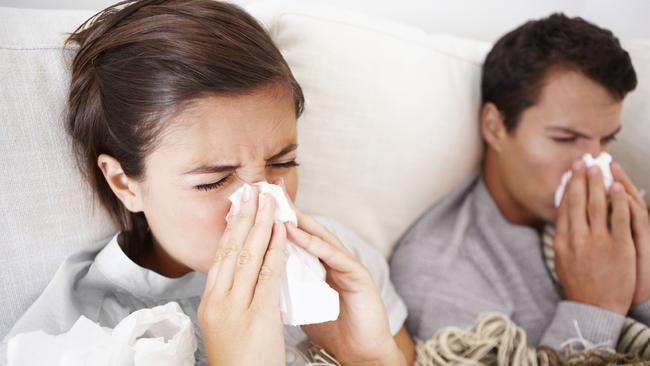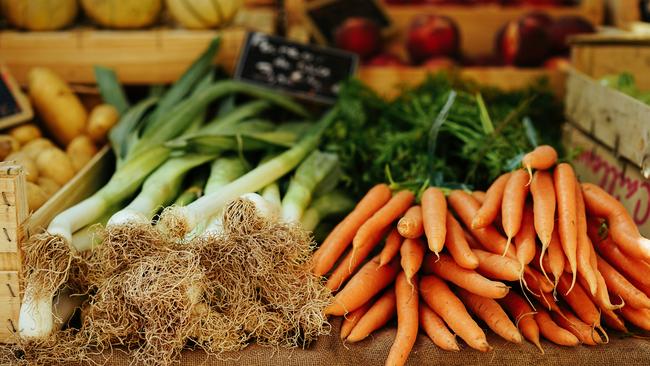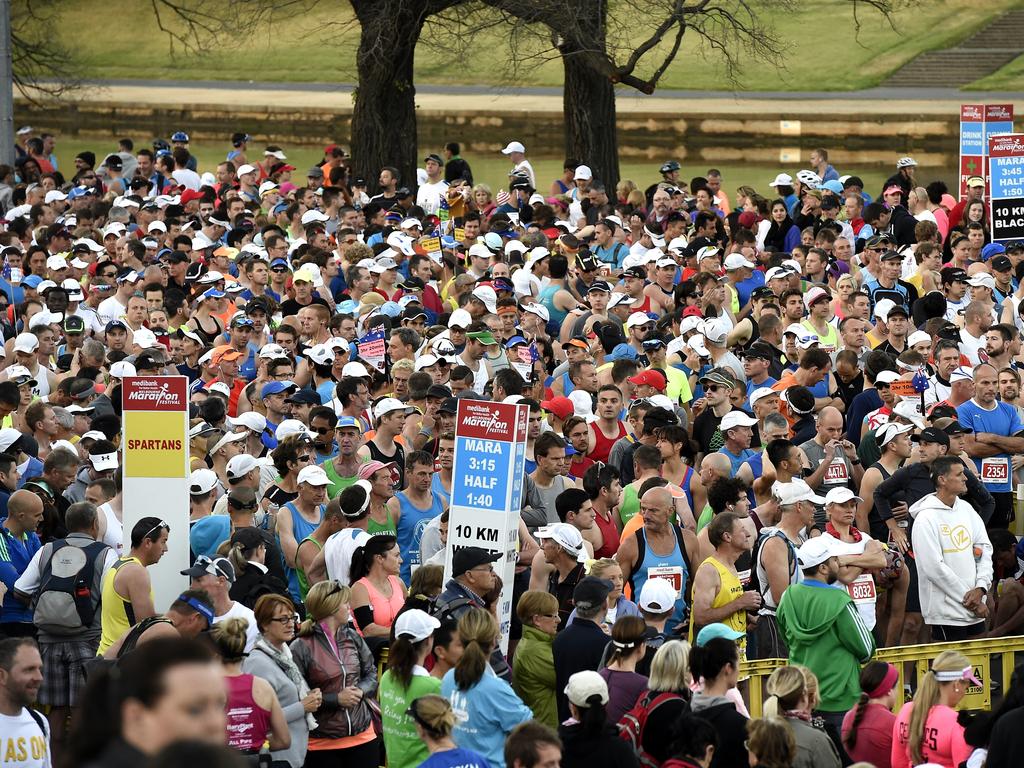Why women need more sleep than men and 9 other health differences between the sexes
From the man flu to gut problems, men and women have vulnerabilities - and strengths - when it comes to health and fitness that set them apart.

When it comes to health and fitness, men and women have vulnerabilities - and strengths - that set them apart. Whereas researchers have recently shown that women are no more prone to feeling the cold than men, there is evidence that they might need more sleep. And while scientists say man flu is not to be sniffed at, the male population can take solace in the fact they are less prone to gut problems than women. But how else do men and women differ in terms of wellness? Here we look at the facts:
1. Women need 20 minutes more sleep

Kevin Morgan, emeritus professor of psychology at Loughborough University’s Clinical Sleep Research Unit, says that women usually need more sleep than men because of a combination of the burden of emotional responsibility they often shoulder at work and home, and “the unique set of hormonal factors” related to the menopause that predisposes women to insomnia.
“There are differences in the complexity and intensity of brain activity during the day that affect women’s sleep needs,” Morgan says. “Twenty minutes is now internationally recognised as the differential in sleep requirement between men and women.”
A study exploring gender differences in sleep loss, conducted last year by researchers at the University of Oxford, reported that women are 58 per cent more likely to experience it than men. However, a team reporting in the Journal of Clinical Sleep Medicine showed that one of the things keeping women awake is a male partner snoring.
2. Contrary to popular belief, women don’t feel the cold more than men
If you are a woman who secretly turns up the central heating or who, like me, needs a pair of gloves on in the summer, you may be surprised by the latest findings from scientists at the US National Institutes of Health (NIH) in Maryland, who reported in the journal Proceedings of the National Academy last month how there is in fact “no sex difference” in how we perceive temperature.
For their trial the NIH team recruited a group of 16 women and 12 men who spent five hours in a temperature-controlled room, wearing provided shirts, shorts or skirts, and socks. Participants were monitored as the temperature ranged between 17C and 31C. Researchers expected the women to fare less well in the chilly environment.
Anecdotally, women have always “felt the cold” more. This was previously thought to be partly because of women’s slower metabolic rate. The faster our bodies generate heat by burning food as fuel, the quicker we warm up and a study conducted several decades ago that looked at differences in metabolic rates of men and women found that men’s metabolic rate is on average 23 per cent faster, in theory helping them to warm up quickly. Hormones also play a role with progesterone and oestrogen known to influence core and skin temperature in women. Female bodies also tend to have less muscle mass than a man of a similar weight - and muscles generate heat.
Yet in the new study, the women were found to have a slightly higher core body temperature in the coldest temperatures than men. In fact, the comfort zone for women was 22C - a full degree lower than for men in the study. The differences could be down to women generally having “a higher body-fat percentage than men of similar body mass index, suggesting that women are more thermally insulated”, the researchers wrote, although they did concede the study was small and needs to be “replicated in larger, more diverse study samples”.
3. Men fall behind on fruit and veg consumption

Dr Linia Patel, a dietician and spokeswoman for the British Dietetic Association, says that when it comes to fruit and veg consumption, men have consistently lagged behind women in each Health Survey for England and National Diet and Nutrition Survey, conducted every three years since 1994. “Not enough men or women get the recommended five-a-day yet,” Patel says. “But it’s well established that fewer men than women meet the target and that women in the UK get more fibre and nutrients from veg and fruit than men.”
There are many reasons for men to eat more fresh produce. One study involving 79,952 men and 93,475 women in the US, published in BMC Medicine, found that men who ate the most fruit, vegetables and legumes had a 22 per cent lower risk of bowel cancer than those who ate the least. There was no such association for women in the study, suggesting a clearer link for men. Urologists at New York University reported that the more fruit, vegetables and legumes consumed by men in middle age, the lower their risk of fatal prostate cancer during a 28-year follow-up.
“Fruit and veg intake correlates strongly with good health,” Patel says. “And the greater the variety of it, the better the outcome.”
4. Women are more prone to iron deficiency
Described by the World Health Organisation as “the most common and widespread nutritional disorder in the world”, iron-deficiency anaemia, caused by a lack of the mineral in the diet, is on the rise and women are most at risk.
Figures from the UK’s most recent National Diet and Nutrition Survey reported that 49 per cent of girls aged 11-18 years and 25 per cent of women aged 19-64 years have low iron intakes and that intakes have dropped in the past decade among adults.
Iron’s principal job is to enable cells to ferry oxygen around the body. Too little iron results in a reduced capacity of blood to carry oxygen, which can leave you breathless and exhausted, suffering headaches and feeling nauseous. But iron has other roles and supports brain and immune function, both of which can be affected when levels are low, Patel says. About 70 per cent of your body’s iron is found in red blood cells, or haemoglobin, and a blood test from your GP or nurse is the only way to determine if haemoglobin levels are below the normal range of 120-150g per litre for women, in which case you might be prescribed a supplement.
To maintain healthy iron levels, the UK government recommends that women aged 50 to 64 need 8.7mg of iron a day and women aged 19 to 50 need 14.8mg a day, and you can get it from food. Of the two types of dietary iron - haem and non-haem - it is the haem iron in meat, fish and poultry that is better absorbed by the body. Liver, red meat, eggs and seafood are all sources of haem iron. Good sources of plant non-haem iron include beans, lentils, green vegetables, hazelnuts, dried fruit, olives, wholegrains, leafy green veg, pumpkin seeds, tofu and dried apricots.
“Women who menstruate heavily or who are pregnant can be prone to lower iron levels,” Patel says. “If you have coeliac disease or inflammatory bowel disease it can also cause impaired iron absorption so be vigilant.”
5. Men are not being dramatic about colds and flu
![Dr Jenna Macciochi says man flu is ‘not about [men] overdramatising symptoms’.](https://content.api.news/v3/images/bin/c2b539815a6ebaa175e23568d65c658e?width=650)
Men are often ridiculed for over-reacting to cold and flu symptoms, but a review published in the BMJ a few years ago by Dr Kyle Sue, a clinical assistant professor in family medicine at the Memorial University of Newfoundland, hinted that man flu is real. Among other things highlighted in that paper were the roles of sex hormones, with suggestions that testosterone could dampen immune response to viruses, while some female hormones could support immunity.
Dr Jenna Macciochi, senior lecturer in immunology at the University of Sussex and author of Immunity: The Science of Staying Well, says man flu is “not about [men] overdramatising symptoms” and that there’s evidence men and women do respond differently to infection. Although reasons are “poorly understood”, it could be that “survival of the species might mean that men are harder hit by infection” whereas “women may have evolved a particularly fast and strong immune response to protect developing foetuses and unborn babies”.
6. Women’s bodies are more flexible
You only need to look around a yoga studio to realise that typically more females find they can touch their toes when men struggle to get beyond their knees.
A 2022 study published in Frontiers in Physiology looked at differences in flexibility between men and women. The researchers from Guangzhou University of Chinese Medicine tested hamstring and lower limb flexibility of a group of male and female participants and concluded that “muscle stiffness of males before and after stretching is always greater than that of females”.
Paul Hobrough, a sports physiotherapist, says that flexibility comes down to the ability of joints, muscles and connective tissue to move through a range without discomfort or pain. “There are many exceptions, with some men being super-flexible, but in general women have the upper hand here,” Hobrough says. “Some of the research suggests that women have a different cell make-up, which means their tendons and ligaments are a bit more lax.”
7. Men eat too much salt
On average, British men consume 9.2g salt a day, according to the most recent government National Diet and Nutrition Survey. It’s too much - more than the 7.6g daily consumed by women and well above the upper target of 6g a day (which is about one teaspoon) set by health chiefs. In England 31 per cent of men (26 per cent of women) have high blood pressure with salt intake a risk factor for the condition, which in turn is linked to heart disease and strokes.
“Cutting down on salt would have a dramatic effect on reducing strokes and heart disease,” says Graham MacGregor, chairman of the campaign group Action on Salt, professor of cardiovascular medicine at the Wolfson Institute of Preventive Medicine and honorary consultant at St George’s Hospital, London. “We should all aim to get under the upper limit of 6g salt per day.”
8. Men are more active
Results of Sport England’s Active Lives surveys, which measure the activity levels of people across England twice a year, show that 25.8 per cent of the population is classed as inactive - averaging less than 30 minutes a week. Men do more sport and physical activity than women in almost every age group and 313,600 fewer adult women than men are regularly active.
In its most recent report, Sport England found that 66 per cent of men questioned (equivalent to 14.9 million men in England) were doing at least the recommended 150 minutes a week of moderate intensity activity needed to stay healthy compared with 61 per cent of women (equivalent to 14.4 million). Women also accumulated fewer daily steps, with results of a global study at Stanford University that used data captured from smartphones showing that women in the UK managed an average of only 4,908 steps a day, while men racked up 5,982.
We could all do better. Every extra step above 2,200 a day - up to 10,500 - was shown to reduce the risk of heart disease and early death in a recent study of more than 70,000 UK people in their sixties. That study, published in the British Journal of Sports Medicine, found benefits of extra steps even if much of the rest of the time is spent sitting.
9. Women have more gut problems
Women are more likely than men to have irritable bowel syndrome or other gut disorders. According to the charity Guts UK, of the 43 per cent of people who have experienced gastrointestinal (GI) issues, it is women who experience more constipation (53 per cent compared with 32 per cent of men), more bloating (62 per cent of women, 41 per cent of men) and tummy pain (67 per cent of women, 58 per cent of men). Some researchers have suggested this is because of sex-related brain functions that cause the GI system to behave differently in women.
In a study at Penn State University a few years ago, researchers discovered nerve cells that controlled the movement of food through the intestines were more sluggish in response to brain prompts in females. “There’s evidence that hormones can have a big influence on gut bacteria and gut health,” says Rhiannon Lambert, registered nutritionist and author of The Science of Plant Based Nutrition. “The presence of female sex hormones including progesterone and oestrogen can affect the female microbiome in many different ways.”
10. Men are the biggest snorers

According to the British Snoring and Sleep Apnoea Association, 41.5 per cent of the UK adult population snore with 10.4 million male and 4.5 million female snorers. Most - 58 per cent - are middle-aged.
Snoring and loud breathing can be symptoms of obstructive sleep apnoea (OSA), which is more than twice as common in men (13 per cent) as women (6 per cent). It’s caused by muscles at the back of the throat relaxing and temporarily blocking airflow during sleep. Being overweight raises the risk of the condition and a waist measurement of more than 94-102cm (37-40in) in men has been associated with OSA.
And do keep tabs on your neck circumference. A recent study from the University of Missouri was the latest to report that men with a neck size of more than 43cm (17in) are more likely to have OSA. A 2023 study of British participants by scientists at the International Sleep Charity and the MRC Toxicology Unit at the University of Cambridge suggests that “sleep apnoea increases the risk of developing insomnia”, resulting in fatigue.
THE TIMES





To join the conversation, please log in. Don't have an account? Register
Join the conversation, you are commenting as Logout